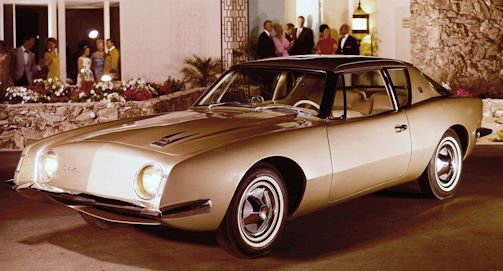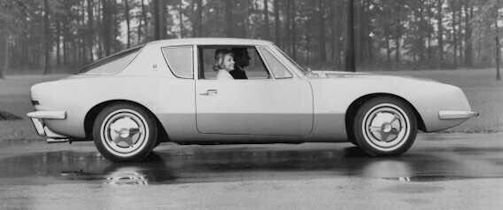Studebaker Avanti
 |
|
|
Production period: |
1962 to 1963 |
|
Class: |
sports car |
|
Body versions: |
Coupe |
|
Engines: |
Gasoline :4.7 litres (179-216 kW) |
|
Length: |
4888 mm |
|
Width: |
1788 mm |
|
Height: |
1368 mm |
|
Wheelbase: |
2770 mm |
|
Curb weight: |
1428-1500 kg |
The Studebaker Avanti was a sports coupe. It was originally manufactured from June 1962 to December 1963 by the American automaker Studebaker Corporation. The production of the Group's self- branded Avanti Motor Corporation, with occasional revisions, continued into 2008.
The very advanced body line for the time was drawn by a designer team around the French industrial designer Raymond Loewy. Avanti in Italian means as much as forward or progress. In fact, the Avanti fell with the first on a US car standard used on all wheel’s disc brakes, smooth front without grille, optional safety belts, safety door locks and integrated roll bar and the great attention to good aerodynamics, the designers act, very much progressive.
The design of the Avanti originated in a five-week working session at a home in Palm Springs, near chief designer Raymond Loewy's home. The design gave the Avanti so many friends that the model survived the downfall of Studebaker and was still produced for decades by hand by successor companies as Avanti II.
Due to the tense financial situation Studebaker could invest in the Avanti development only little money. Therefore, the so modern appearing Avanti under the fiberglass shell on the frame of the Studebaker Lark convertible, which went back in its origins to the year 1953. In the engines, the factory resorted to the existing in-house 4.7-liter V8, which was available in several power levels.
Loewy further developed the design of the Avanti. In 1963 he designed a four-door sedan and a two-door hatchback coupe with design elements of the Avanti. The French body manufacturer Pichon-Parat built a prototype of each design; However, it did not come to mass production.
In the basic version mentioned R-1, the 4.7-liter V8 used in the Avanti made 179 kW (240 gross SAE-PS), the optionally available version R-2 came with a Paxton compressor to 216 kW (289 hp). The displacement equal Ford V8 made for comparison in the Mustang 147 kW (210 hp), or 156 kW (220 hp) with quadruple carburettor or 199 kW (271 hp) in the Hi-Po called high-performance version.
PERFORMANCE:
Engine capacity: 289.00 cu in, 4725.15 cu cm;
Fuel consumption: 17.1 m/imp gal, 14.2 m/US gal, 16.5 1 x 100 km;
Max speed: 124.2 mph, 200 km/h;
max speed in 1st gear: 48.4 mph, 78 km/h; max speed in 2nd gear: 80.1 mph, 129 km/h; max speed in 3rd gear: 124.2 mph, 200 km/h;
power-weight ratio: 15.0 lb/hp, 7.1 kg/hp
useful load: 706 1b, 320 kg.
With the help of race pilot Andy Granatelli, Studebaker also developed an R-3 engine for the Avanti. For the 4.7-liter engine was initially drilled to 4.9 litres, later to 5.0 litres. The R-3 featured special cylinder heads with much larger intake ports and valves, an aluminium intake manifold, sport exhaust manifold, sharper camshaft, Paxton supercharger and Carter AFB quad carburettor. Thus, the R-3 officially came to 250 kW (335 hp), measurements on the test bench should have yielded values around 295 kW.
The strongest version of the Studebaker V8 was the R-5, which was developed for experimental purposes only. With one compressor per cylinder bank, this engine came to no less than 429 kW (575 hp). The engine was used in Granatelli's Avanti Duecento called special car, with which he wanted to crack the limit of 200 miles per hour (323 km / h). However, Granatelli came in the record runs in Bonneville only to 316.36 km / h.
In the summer and autumn of 1963, Granatelli made record runs with a standard Avanti with R-3 engine on the Salt Lake near Bonneville. He reached a top speed of almost 275 km / h and set 34 US records, which allowed Studebaker at that time to promote the Avanti as "fastest production car in the world".
Production at Studebaker
Studebaker advertised the Avanti at an early stage, and many interested parties placed advance orders. However, there were delays in the development, which had a negative impact on the sales figures. The main reason for the delays were problems with the fit of some fiberglass body panels; In addition, the opening for the rear window proved too large for the disc. This came as a surprise, after all, the production of the body panels was given to the same company that had been producing the bodies of the Chevrolet Corvette since 1953. In the end, Studebaker was forced to make the panels himself - but by then, many customers had already cancelled their orders.
Studebaker renounced the Avanti on the marking of different model years, but rather let necessary changes in the current series flow. Early and late Studebaker Avanti’s is most easily distinguished by the headlight fairings. All Avanti’s between June 1962 and July 1963 had round panels. From August 1963, square panels were used.
In December 1963, Studebaker announced that it would stop car production at its headquarters in South Bend, Indiana and produce only in Hamilton, Canada. At the same time the Avanti, the Studebaker Hawk and all pickups and trucks fell out of the program; In Canada limousines, coupes and station wagons were built for a while.
Studebaker made 4643 copies until the setting of the Avanti. To the last Avanti, a white R-3 with all extras, Studebaker employees attached a letter in which they informed the future owner about the historic importance of the car.
Studebaker survived two more years, producing the Commander, Daytona and Cruiser models in Canada with General Motors engines.
Avanti II
Following the cessation of production at Studebaker's South Bend site, two Studebaker dealers, Nate Altman and Leo Newman, acquired the rights to the Avanti name and all existing tools, Molds, Avanti parts, etc. and part of the former Studebaker Factory to continue the production of Avanti. Altman and Newman first turned to Checker, known for building the Checker taxis, to clarify the possibilities to manufacture the Avanti there; Company owner David Markin is said to have replied that he has no interest in an "ugly car" like the Avanti. As a result, Altman and Newman took the matter into their own hands and hired numerous former Studebaker employees, who built the Avanti II by hand from then on; until the beginning of the 1980s, about 150-250 copies were produced annually.
However, it was no longer the Studebaker V8, but an eight-cylinder from the Chevrolet Corvette for use, first the 5.4-liter, later the 5.7-liter, the 6.6-liter and finally the five-Liter V8.
After the death of Altman and Newman, the realtor and Avanti client Stephen Blake took over the company. Blake went bankrupt in 1986, and the company passed into the hands of Michael Kelly. In 1987, production was relocated to Ohio. The new model was now based on the platform of the Chevrolet Camaro / Pontiac Firebird, which also four-door and convertible versions were possible. There have been a number of design changes, including wide bumpers painted in body colour.
A new Avanti
Tom Kellogg, who once belonged to the group around Raymond Loewy and was involved in the design of the original Studebaker Avanti, was commissioned in the late 1990s to revise the Avanti. The AVX designated new design is built by the company Avanti Motor Corporation since 2001, from 2004, Ford delivers the platform and apparently the 4.6-liter V8 with 227 kW (304 hp). For 2006, the company also announced an Avanti with four-Liter V6 (210 hp) and a supercharged version of the 4.6-liter with 348 kW (467 hp). Prices start at $ 62,000. Since 2006, the Avanti is manufactured in Cancun, Mexico.
VARIATIONS AND OPTIONAL ACCESSORIES:
axle ratio 3.31 -4.09-3.07: 1; power-assisted steering, 3.5 turns of steering wheel lock to lock; limited slip final drive; overdrive, ratio 0.70; Flight-o-Matic automatic gear box Paxton supercharger

Technical
-
DIMENSIONS AND WEIGHT:
wheel base: 109.00 in, 2769 mm
front track: 57.40 in,1458 mm
rear track: 56.60 in, 1438 mm
overall -length: 192.48 in, 4889 mm
overall width: 70.40 in, 1788 mm
overall height: 53.90 in, 1369 mm
ground clearance: 5.12 in, 130 mm
dry weight: 3310 1b, 1501 kgENGINE:
front, 4 stroke; cylinders: 8, Vee-slanted at 90°
bore and stroke:3.56 x 3.62 in, 90.4 x 91.9 mm
engine capacity: 289.00 in. 4725.15 cu cm
1 Carter downdraft twin-barrel carburettor
fuel feed: mechanical pump
cooling system: water
cylinder block: cast iron
cylinder head: cast iron
crankshaftTRANSMISSION:
driving wheels: rear
clutch: single dry plate
gear box: mechanical; gears: 3 + reverse
gear box ratios (I) 2.57, (II) 1.55, (III) 1, (Rev) 3.48
gear lever: central
final drive: hypoidCHASSIS:
box-type ladder frame with X cross members
front suspension:independent, wishbones, coil springs, anti-roll bar, telescopic dampers
rear suspension: rigid axle, semi-elliptic leafsprings, radius rods, telescopic dampers.STEERING:
cam and peg
turns of steering wheel lock to lock 5.
turning radius (between walls): 20.0 ft, 6.1 mELECTRICAL EQUIPMENT:
voltage: 12 V
battery: 50 Ah
alternator: 40 Ah
ignition distributor: Autolite
headlights: 4 front and reversing.
Service
-
fuel: petrol
lubricating system total capacity: 5.0 imp qt. 6.0 US qt.
engine sump oil: 4.1 imp 5.0 US qt, 4.7 1, SAE 5W-20 (winter) 10W-30 (summer), change every 6000 miles,9600 km
gearbox oil: 1.6 imp qt, 1.9 US 1.8 1, SAE 90
cooling system capacity: 15.0 imp qt. 18.0 US qt
final drive oil:1.0 imp qt, 1.3 Us qt, 1.2 1, SAE 90
tappet clearances: inlet 0.024 in,0.61 mm, exhaust 0.026 in, 0.66 mm
valve timing: (inlet) opens 11° before tdcand closes 54° 36' after bdc, (exhaust) opens 51° 36' before bdc and closes 14°after tdc
tyre pressure (medium load): front 24 psi, 1.7 atm, rear 24 psi, 1.7 atm-
tyres: 6.70 - 15
fuel tank capacity: 17.60 imp gal© Motor car History
Manuals
-
Studebaker Previous 4 / 25 Next
